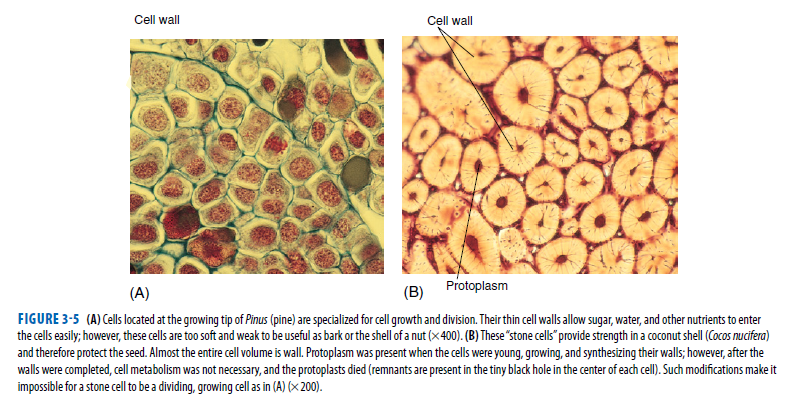Cell wall Cell wall (A) Protoplasm (B) FIGURE 3-5 (A) Cells lcated at the growing tip of Pinus (pine) are specialized for cell growth and division. Their thin cell walls allow sugar, water, and other nutrients to enter the cells easily; however, these cells are too soft and weak to be useful as bark or the shell of a nut (x400). (B) These "stone cells" rovide strength in a coconut shell (Cocos nucifera) and therefore protect the seed. Almost the entire cell volume is wall. Protoplasm was present when the cells were young, growing, and synthesizing their walls; however, after the walls were completed, cell metabolism was not necessary, and the protoplasts died (remnants are present in the tiny black hole in the center of each cell). Such modifications make it impossible for a stone cell to be a dividing, growing cell as in (A) (x 200).
Cell wall Cell wall (A) Protoplasm (B) FIGURE 3-5 (A) Cells lcated at the growing tip of Pinus (pine) are specialized for cell growth and division. Their thin cell walls allow sugar, water, and other nutrients to enter the cells easily; however, these cells are too soft and weak to be useful as bark or the shell of a nut (x400). (B) These "stone cells" rovide strength in a coconut shell (Cocos nucifera) and therefore protect the seed. Almost the entire cell volume is wall. Protoplasm was present when the cells were young, growing, and synthesizing their walls; however, after the walls were completed, cell metabolism was not necessary, and the protoplasts died (remnants are present in the tiny black hole in the center of each cell). Such modifications make it impossible for a stone cell to be a dividing, growing cell as in (A) (x 200).
Biology: The Dynamic Science (MindTap Course List)
4th Edition
ISBN:9781305389892
Author:Peter J. Russell, Paul E. Hertz, Beverly McMillan
Publisher:Peter J. Russell, Paul E. Hertz, Beverly McMillan
Chapter4: Cells
Section: Chapter Questions
Problem 13TYK
Related questions
Concept explainers
Question
Stone cells in coconut shells are part of the division of labor in plants. What modifications do they have that make it impossible for them to be dividing and growing cells ?

Transcribed Image Text:Cell wall
Cell wall
(A)
Protoplasm
(B)
FIGURE 3-5 (A) Cells lcated at the growing tip of Pinus (pine) are specialized for cell growth and division. Their thin cell walls allow sugar, water, and other nutrients to enter
the cells easily; however, these cells are too soft and weak to be useful as bark or the shell of a nut (x400). (B) These "stone cells" rovide strength in a coconut shell (Cocos nucifera)
and therefore protect the seed. Almost the entire cell volume is wall. Protoplasm was present when the cells were young, growing, and synthesizing their walls; however, after the
walls were completed, cell metabolism was not necessary, and the protoplasts died (remnants are present in the tiny black hole in the center of each cell). Such modifications make it
impossible for a stone cell to be a dividing, growing cell as in (A) (x 200).
Expert Solution
This question has been solved!
Explore an expertly crafted, step-by-step solution for a thorough understanding of key concepts.
This is a popular solution!
Trending now
This is a popular solution!
Step by step
Solved in 2 steps

Knowledge Booster
Learn more about
Need a deep-dive on the concept behind this application? Look no further. Learn more about this topic, biology and related others by exploring similar questions and additional content below.Recommended textbooks for you

Biology: The Dynamic Science (MindTap Course List)
Biology
ISBN:
9781305389892
Author:
Peter J. Russell, Paul E. Hertz, Beverly McMillan
Publisher:
Cengage Learning

Biology (MindTap Course List)
Biology
ISBN:
9781337392938
Author:
Eldra Solomon, Charles Martin, Diana W. Martin, Linda R. Berg
Publisher:
Cengage Learning

Biology 2e
Biology
ISBN:
9781947172517
Author:
Matthew Douglas, Jung Choi, Mary Ann Clark
Publisher:
OpenStax

Biology: The Dynamic Science (MindTap Course List)
Biology
ISBN:
9781305389892
Author:
Peter J. Russell, Paul E. Hertz, Beverly McMillan
Publisher:
Cengage Learning

Biology (MindTap Course List)
Biology
ISBN:
9781337392938
Author:
Eldra Solomon, Charles Martin, Diana W. Martin, Linda R. Berg
Publisher:
Cengage Learning

Biology 2e
Biology
ISBN:
9781947172517
Author:
Matthew Douglas, Jung Choi, Mary Ann Clark
Publisher:
OpenStax

Human Heredity: Principles and Issues (MindTap Co…
Biology
ISBN:
9781305251052
Author:
Michael Cummings
Publisher:
Cengage Learning